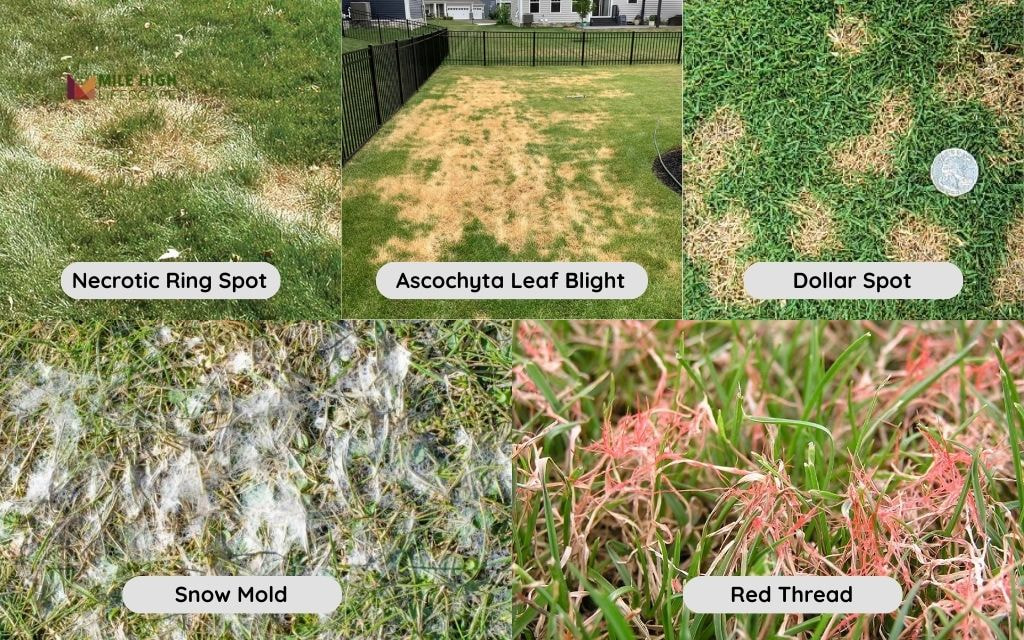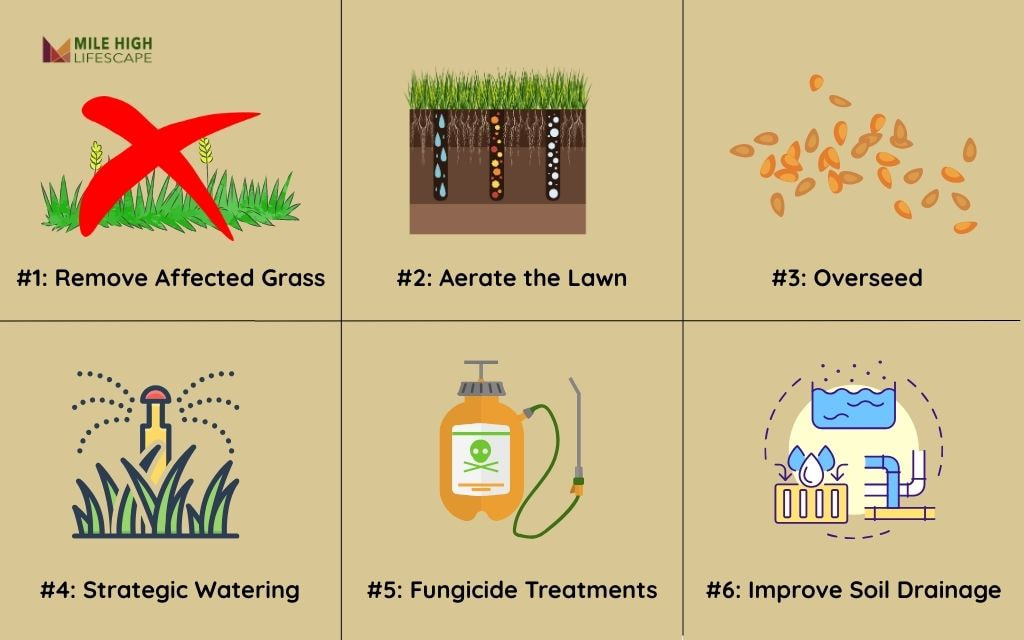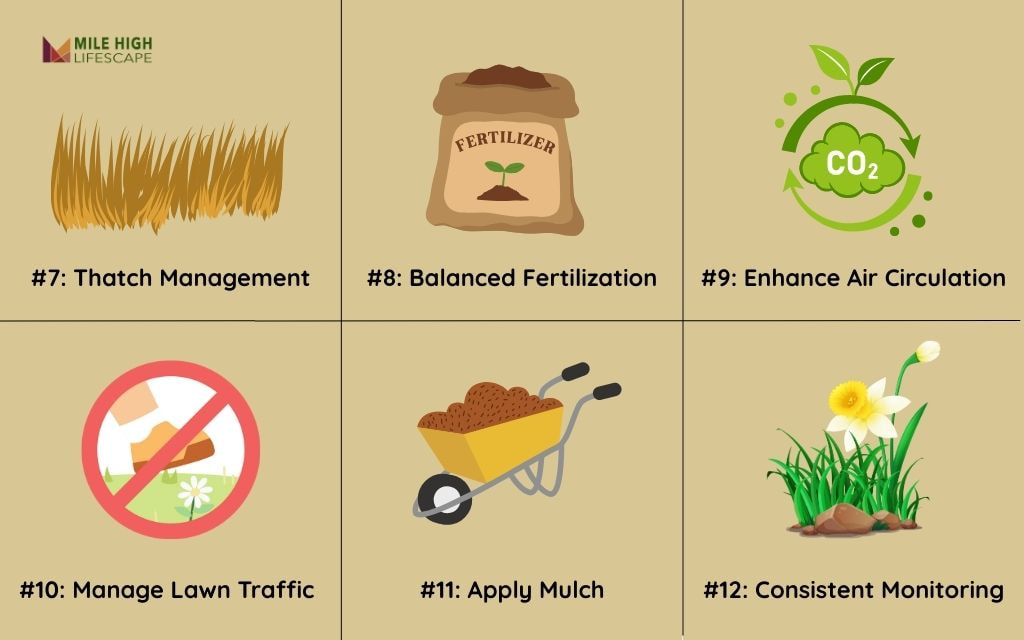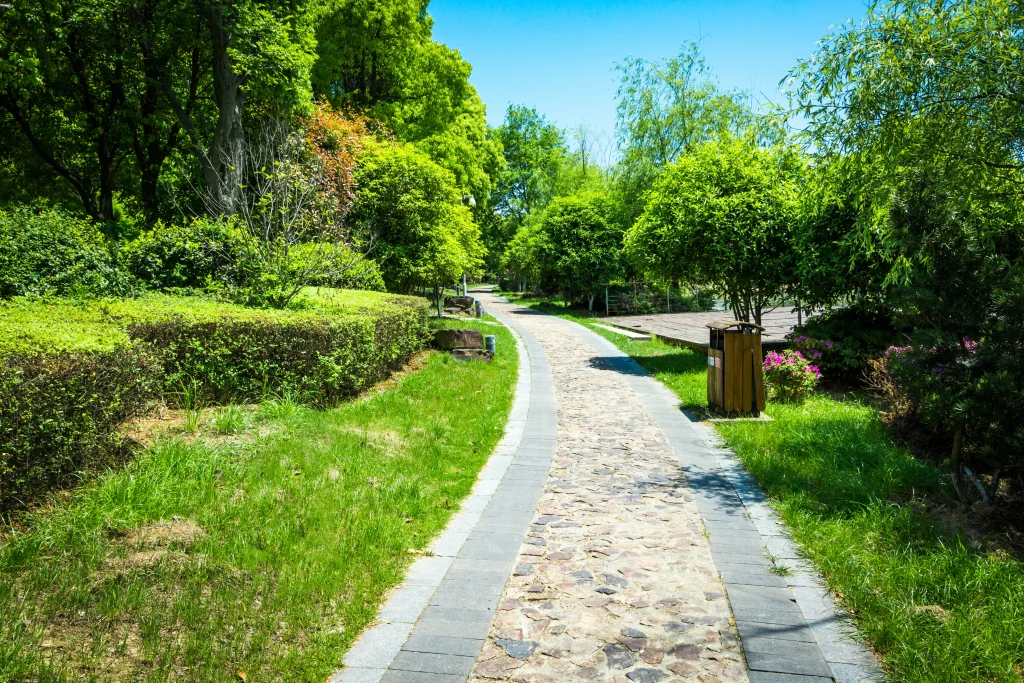Denver homeowners face a persistent challenge with lawn fungus manifesting as brown patches, thinning grass, and uneven growth patterns across their yards. At Mile High Lifescape, we understand the frustration of watching your once-vibrant lawn deteriorate from fungal infections.
This comprehensive guide equips you with the knowledge to identify common lawn fungus, implement effective treatment methods tailored to our regional conditions, and establish prevention practices that maintain lawn health while respecting water conservation needs.
What Causes Lawn Fungus in Denver?
Denver’s distinctive climate and elevation create specific conditions that promote fungal growth in residential lawns. Understanding these regional factors helps homeowners address the root causes rather than just treating symptoms.
Several common factors contribute to lawn fungus:
- Inconsistent Moisture Management: Watering restrictions often lead to improper irrigation practices. Many homeowners compensate with excessive watering during permitted days, creating moisture imbalances that fungi exploit.
- Temperature Fluctuations: Our region experiences dramatic temperature swings, sometimes 40+ degrees within 24 hours. These fluctuations stress grass and create vulnerability to fungal invasion.
- High Altitude Conditions: Denver’s elevation means more intense UV exposure and quicker evaporation, leading to stress on grass that wasn’t cultivated specifically for high-altitude environments.
- Soil Compaction: Clay-heavy soils combine with foot traffic to create compaction that traps moisture and limits air circulation, creating fungal-friendly conditions.
- Improper Fertilization Practices: Many homeowners apply excessive nitrogen fertilizer, especially in spring, creating lush but weak growth susceptible to fungal infections.
Common Types of Lawn Fungus Found in Denver
Denver lawns typically encounter specific fungal diseases adapted to our regional conditions. Identifying the precise lawn fungus is crucial for implementing effective treatment.
Necrotic Ring Spot (Ophiosphaerella korrae)
The most prevalent lawn fungus, especially those with Kentucky bluegrass. It creates distinctive circular patches with “frog-eye” patterns—dead grass surrounding small tufts of living grass. This soil-borne fungus attacks grass roots and thrives during Colorado’s cool, wet springs.
Ascochyta Leaf Blight
Commonly emerges after rapid temperature shifts in late spring and early summer. It causes grass to turn straw-colored within 24-48 hours, creating a uniformly brown appearance that many homeowners mistake for drought stress.
Dollar Spot (Sclerotinia homoeocarpa)
Forms silver-dollar-sized spots of bleached or straw-colored grass. This fungus becomes active when night temperatures exceed 50°F with high humidity or extended dew periods – conditions that develop during summer evenings.
Snow Mold (Typhula spp. or Microdochium nivale)
Appears in early spring as circular patches of matted, tan or pink-tinged grass after snow melts. The fungus develops under snow cover and affects lawns particularly in shaded areas where snow persists.
Red Thread (Laetisaria fuciformis)
Creates irregular patches with distinctive red or pink threads extending from grass blades. This fungus emerges during cool, wet conditions and targets lawns with low nitrogen levels – common in lawns subject to watering restrictions.

How to Restore a Lawn Afflicted with Fungus: 12 Solutions
Reviving lawn fungus requires a strategic, regionally appropriate approach. The following comprehensive restoration plan addresses both immediate treatment and long-term recovery suited to our unique climate conditions.
#1: Remove Affected Grass
The first step in lawn restoration requires removing severely damaged grass to eliminate the source of infection. Use a rake or dethatcher to remove dead grass, then bag and dispose of the material rather than composting it to prevent spore transmission.
For Denver lawns with Necrotic Ring Spot, more aggressive removal may be necessary since the fungus resides in soil and root systems.
#2: Aerate the Lawn
Core aeration proves essential for Denver’s clay-heavy soils that tend toward compaction. This process creates channels for water, air, and nutrients to penetrate the root zone. Schedule aeration during early fall or spring when soil moisture levels support proper plug removal.
For lawns with severe fungal damage, consider double-pass aeration to maximize soil exposure and relieve compaction in areas where water tends to pool.
#3: Overseed with Disease-Resistant Grass Varieties
Select grass varieties that offer improved fungal resistance. For Kentucky bluegrass lawns susceptible to Necrotic Ring Spot, introduce blends containing turf-type tall fescue or perennial ryegrass to increase diversity and disease resistance.
These varieties handle both drought conditions and disease pressure more effectively than single-species lawns.
#4: Implement Strategic Watering Practices
Adopt watering protocols that discourage fungal development while respecting Denver’s watering restrictions. Water deeply (approximately 1-1.5 inches) but infrequently – ideally before 10 a.m. – to allow grass blades to dry completely during daylight hours.
Install soil moisture sensors to prevent overwatering and program irrigation systems to adapt to seasonal needs rather than maintaining the same schedule year-round.
#5: Apply Appropriate Fungicide Treatments
Select fungicides specifically formulated for the identified lawn fungus. For persistent issues like Necrotic Ring Spot, apply systemic fungicides containing active ingredients such as azoxystrobin or propiconazole according to label instructions.
Consider organic alternatives like corn meal gluten for minor infections, especially in areas where children and pets play frequently.
#6: Improve Soil Drainage
Address drainage issues contributing to moisture retention and fungal growth. For Denver’s clay soils, incorporate organic matter like compost to improve structure and drainage capability.
Consider installing French drains in areas where water consistently pools after rainfall or irrigation, particularly in shadier sections of the lawn where evaporation rates decrease.

#7: Implement Thatch Management
Control thatch buildup that harbors fungal spores and creates moisture barriers between soil and grass. For Denver lawns, maintain thatch layers at less than half an inch through regular dethatching and core aeration. Schedule these operations during early fall to allow recovery before winter dormancy periods.
#8: Adopt Balanced Fertilization
Implement fertilization practices that support steady, resilient growth rather than rapid, weak development. Apply slow-release fertilizers with appropriate NPK ratios for your specific grass type in alignment with seasonal needs.
Reduce nitrogen applications during periods of high humidity or when fungal pressure increases, typically during late spring and early summer in Denver.
#9: Enhance Air Circulation
Improve airflow across the lawn surface to reduce humidity and moisture retention.
Trim overhanging branches, thin dense shrubs around lawn perimeters, and consider incorporating hardscape elements that create natural airflow channels.
For homeowners with fenced yards, consider strategic fence designs that allow prevailing winds to move across the lawn’s surface.
#10: Manage Lawn Traffic
Direct foot traffic away from recovering areas to prevent soil compaction and grass damage. Install stepping stones or gravel pathways in heavily traversed areas, especially those connecting functional spaces like patios, gardens, or outbuildings. Deploy temporary fencing around severely damaged sections to allow complete recovery.
#11: Apply Mulch Strategically
Use organic mulch in garden beds adjacent to lawn areas to reduce weed growth and water competition without encroaching on grass.
Maintain proper mulch depths of 2-4 inches and create clean transitions between mulched areas and lawn edges to prevent fungal spread from organic decomposition zones to grass.
#12: Establish a Consistent Monitoring System
Develop a regular inspection routine that identifies early signs of fungal recurrence. Document problem areas with photographs and notes about seasonal timing, weather conditions, and irrigation frequencies. This data helps establish patterns that facilitate proactive treatment before extensive damage occurs.

Preventing Lawn Fungus in the Future
Preventing fungal recurrence requires systematic cultural practices tailored to Denver’s unique growing conditions. Implement these preventative measures to maintain long-term lawn health:
- Maintain Optimal Mowing Heights: Keep cool-season grasses at 3-4 inches, especially during summer stress periods. This height promotes deeper root development and enhances drought tolerance while reducing fungal vulnerability.
- Establish Proper Watering Cycles: Water lawns between 4 a.m. and 10 a.m. to maximize absorption and minimize leaf wetness duration. Follow Denver Water guidelines while ensuring your lawn receives 1-1.5 inches of water weekly during growing seasons.
- Implement Seasonal Core Aeration: Schedule core aeration annually in early fall to reduce compaction, improve root development, and enhance thatch decomposition before winter dormancy.
- Select Regionally Appropriate Grass Blends: Introduce diverse grass species suited to Denver’s climate, including drought-resistant varieties that maintain vigor during watering restrictions.
- Apply Preventative Biofungicides: Consider corn meal gluten or beneficial bacterial applications during early spring and late summer transition periods when fungal pressure typically increases.
- Balance Soil Nutrients: Conduct soil tests every 2-3 years and adjust fertilization practices based on actual nutrient needs rather than general recommendations.
- Reduce Shade Stress: Prune trees and shrubs to improve sunlight penetration, particularly in areas prone to snow mold or dollar spot development.
Conclusion
Restoring a fungus-damaged lawn in Denver requires understanding our region’s unique challenges and implementing solutions specifically designed for our climate and soil conditions.
With proper identification, targeted treatment, and consistent preventative practices, your lawn can recover its health and resilience.
At Mile High Lifescape, we’ve helped Denver homeowners transform lawn fungus into vibrant outdoor spaces for nearly two decades. Our professional lawn treatment services address fungal issues with regionally appropriate solutions that respect water conservation needs while maximizing lawn health.
Contact us for customized lawn restoration plans tailored to your property’s specific conditions and your family’s needs.
Frequently Asked Questions (FAQs)
How do you get rid of lawn fungus?
To get rid of lawn fungus, first identify the specific type affecting your lawn, then implement appropriate cultural practices including proper watering, mowing, and aeration. Apply fungicides specifically formulated for the identified fungus, following label instructions precisely.
What does fungus look like in a lawn?
Lawn fungus appears as circular patches of discolored grass, ranging from yellow to brown or gray. Some fungi create distinctive patterns like rings or “frog eyes” (dead circles with living centers), while others produce visible threads, powdery substances, or slimy coatings on grass blades. During active growth periods, you might observe mushrooms emerging in affected areas, particularly after rainfall.
What is the 150 rule for lawn fungus?
The 150 rule for lawn fungus states that fungal pathogens become most active when the combined temperature and humidity percentage equals or exceeds 150. For example, when the temperature is 80°F and humidity is 70%, the total is 150 – creating ideal conditions for fungal development.
Should you fertilize a lawn with fungus?
No, avoid fertilizing a lawn actively affected by fungus, particularly with nitrogen-rich products that stimulate lush growth susceptible to further infection. Wait until the fungal issue is controlled before applying fertilizer, then use a balanced, slow-release formula that promotes steady, resilient growth rather than rapid, vulnerable development.
Will grass killed by fungus grow back?
Yes, grass killed by fungus will often grow back naturally in mild cases, particularly with improved cultural practices. For severe infections that have damaged the root systems, reseeding or sodding may be necessary.
